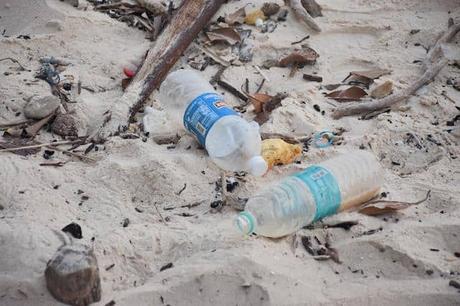The plastic debris consisting of 414 million pieces including 977,000 shoes, 373,000 toothbrushes, bottles, cutlery, bags, and straws have covered up the beaches of the tiny Cocos (Keeling) Islands with a population of just 600.
Located 2,100 km off Australia’s northwest coast, this island in the Indian Ocean is among the Earth’s most remote places, and the comprehensive survey of debris on the islands found a staggering amount of rubbish weighing 238 tonnes washed ashore.

The volume of debris indicates the exponential increase of global plastic polluting the oceans around the world, the study, published in the journal Nature, concluded. It “highlights a worrying trend in the production and discharge of single-use products.”
Jennifer Lavers, the lead author from the University of Tasmania’s Institute of Marine and Antarctic Studies, said remote islands and those without large populations are becoming the most useful indicator of the amount of floating plastic debris in the oceans.
“Islands such as these are like canaries in a coal mine, and it’s increasingly urgent that we act on the warnings they are giving us. Plastic pollution is now ubiquitous in our oceans, and remote islands are an ideal place to get an objective view of the volume of plastic debris now circling the globe,” Lavers explained.
The quantity of debris buried up to 10cm underneath the beach was 26 times more than the visible amount of trash, as per the study and also those previous surveys that only assessed surface garbage might have “drastically underestimated the scale of debris accumulation.”
Our oceans have been a reservoir for exponentially increasing plastic waste over 60 years. From the deepest oceanic trenches to the most far-flung beaches, plastic has been documented at all levels of the marine food web.
A previously published study led by Lavers in 2017 found that the remote Henderson Island in the eastern South Pacific was among the places most affected by plastic pollution.
The debris found on Henderson Island was mostly fishing-related whereas, on the Cocos (Keeling) Islands, there mainly was single-use plastic items such as bottles, bags, plastic cutlery, and straws.
“Our excessive and unrelenting demand for plastics, coupled with ineffective policy and waste management, has resulted in myriad negative effects on marine, freshwater, and terrestrial environments, including entanglement and ingestion of debris, and subsequent exposure to plastic-associated chemicals,” the report said.
“The Cocos (Keeling) Islands [are] touted as ‘Australia’s last unspoilt paradise,’ with tourism a primary source of income for the local community. However, the impact of debris on tourism and [their] beaches is increasingly difficult to avoid.
“Sadly, the situation on the Cocos (Keeling) Islands is not unique, with significant quantities of debris documented on islands and coastal areas from the Arctic to the Antarctic. Together, these islands and coastal areas reflect the acute symptoms of an otherwise rapidly increasing environmental hazard.”
The shoes and toothbrushes found in such large quantities that, according to the researchers, it would take the local population around 4,000 years to generate the same amount of waste.
The local community has struggled in searching for an appropriate landfill site, or some other ways to dispose of the garbage appropriately.
“In the absence of rapid and meaningful change, anthropogenic debris will accumulate on beaches, with impacts increasingly felt by biodiversity and marine plastic mitigation will remain a perpetual game of catch-up,” the report found.
“Mitigation initiatives, including policy, should be mindful of the challenges faced by remote islands, and the communities that reside there.”
Annett Finger, a co-author of the report from Victoria University, said global production of plastic continues to increase. Since 2006 the amount of plastic produced is almost half than that manufactured in the last 60 years.
“An estimated 12.7m tonnes of plastic entered our oceans in 2010 alone, with around 40% of plastics entering the waste stream in the same year they’re produced,” Finger mentioned.
“As a result of the growth in single-use consumer plastics, it’s estimated there are now 5.25 trillion pieces of ocean plastic debris.
“The scale of the problem means cleaning up our oceans is currently not possible, and cleaning beaches once they are polluted with plastic is time consuming, costly, and needs to be regularly repeated as thousands of new pieces of plastic wash up each day.”

